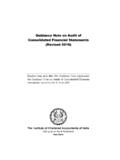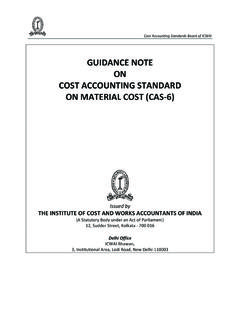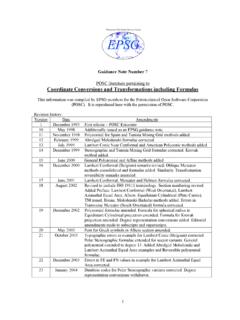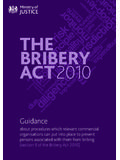Transcription of Guidance Note for Project Management - World Bank
1 Guidance Note for Project Management Strengthening Institutional Capacity during Project Implementation October 2005. FOREWORD. Helping to build country institutional capacity is at the heart of the World Bank's mission to promote sustainable development and poverty reduction. Greater integration of Project Management in a country's existing institutions and systems is important to this goal, and to the Bank's effort to move toward greater use of country systems in lending. The Paris Declaration on Aid Effectiveness adopted at the High-Level Forum in March 2005 reaffirmed the donor community's commitment to align their programs to national development strategies, institutions, and procedures. It identified a reduction in the number of parallel Project implementation units (PIUs) as one of the key actions the aid community could take to promote greater capacity development within our borrowers, and thus increase aid effectiveness.
2 The organizational structure for Project Management is often chosen to mitigate risk in a weak capacity environment, but it may also reflect internal incentives that focus on speed of Project processing and disbursement, and perceived stigmas in low implementation performance ratings. The result is often the use of PIUs sometimes semi-permanently even though regional studies have shown that they are suboptimal organizational arrangements and create problems of morale among government officials. While there are examples of good efforts during Project design and implementation to focus on sustainable institutional capacity development and use of country systems, they are rare. This note aims to encourage operations managers and staff not only to give priority to Project implementation performance but also to balance it with sustainable institutional capacity development beyond the Project .
3 To that end, existing country institutions should be the default mode, and PIUs especially parallel stand-alone PIUs should be phased out. This note reflects lessons learned and draws on existing good practices in the expectation that they can become the rule rather than the exception. I encourage all operations staff and managers to read this note as they plan for new operations and to reflect its recommendations in their ongoing work. James W. Adams Vice President Operations Policy and Country Services Abbreviations and Acronyms CAS Country Assistance Strategy ECA Europe and Central Asia Region OED Operations Evaluation Department PAD Project Appraisal Document PIU Project implementation unit SWAp Sectorwide approach Contents I.
4 Introduction .. 1. II. Background .. 3. III. Good Practice Adapting Bank Processes and Systems .. 8. A. Country/Sector Dialogue 8. B. Project Design and Implementation 13. IV. Management , Skills, and Incentives Issues .. 17. Annex: Good Practice Examples 1. China: Using Existing Organizational Structures for Project 23. 2. Lao PDR: Road Sector New Implementation 25. 3. Tanzania: Health Sector From PIU to Government Structures under a Sectorwide Approach .. 27. 4. Albania: Public Administration Reform Project . An Integrated Implementation System .. 29. Guidance Note for Project Management Strengthening Institutional Capacity during Project Implementation I. Introduction 1. This note is intended to help shift the implementation paradigm for Bank-financed operations toward organizational structures that systematically foster more sustainable capacity development through greater use of and support for country systems and institutions, while ensuring timely Project implementation and disbursement.
5 The Bank has long recommended that stand-alone Project implementation units (PIUs) be mainstreamed into existing ministry structures, because they are inconsistent with the Bank's mission of capacity development and institutional strengthening in developing countries. 1 However, many projects continue to Note: Preparation of this note was coordinated by Chiyo Kanda (task manager) and M. Sri-Ram Aiyer (consultant and primary author), Operations Policy and Country Services. Regional practices and recent studies on PIUs were reviewed in 2004. 1 As long ago as the early 1980s, the Bank issued a Central Projects Note on Project Management to this effect. Later, the Bank's Senior Vice President, Operations, determined that operations and maintenance expenditures, including special pay for government officials assigned or released to PIUs, were ineligible for financing with loan/credit proceeds, as operations and maintenance costs should be financed by government budgets.
6 In 2003, the substantive message on PIUs was repeated by the Operations Evaluation Department, which also noted that capacity development within a PIU does not spill over into the ministry where it is located, and that the selection and composition of technical assistance through PIUs reflect donor rather than government preferences; see Toward Country- led Development: A Multi-Partner Evaluation of the Comprehensive Development Framework, 2003. Guidance NOTE FOR Project Management . rely on PIUs because external and internal incentives work toward organizational arrangements that favor the short-term goal of safeguarding Project fiduciary and performance objectives. 2. Focus. The focus of this note is twofold: (a) on the nature and design of organizational structures for implementation of Bank-financed projects and the priority accorded to sustainable country institution development; 2 and (b) on internal incentives and practices to support Bank staff in assisting borrowers with Project Management .
7 3. Purpose. The note aims to raise awareness among Bank staff and managers, stimulate sharing of experiences across Regions and sectors, and foster deeper reflection on development effectiveness during the preparation and implementation of lending operations. It is primarily intended as internal Guidance to Bank staff and managers, but is also expected to contribute to knowledge on good practice that can be shared with borrowing country officials and other external partners. 4. The note recognizes that the approach and pace of transition from PIUs to government ministries and institutions will vary by country and by Project . Therefore, it does not attempt to prescribe how to because of the wide differences among countries and sectors in their implementation capacity and specific needs and circumstances.
8 5. The note by itself is not sufficient to make a difference in practice; the new implementation paradigm will have to be applied in day-to-day operations by staff and managers for example, task team leaders, who lead Project 2 The issue is not the title PIU per se, but the organizational structure designed for Project implementation and its effects on the longer-term capacity of local institutions. The aim is to make attention to institution building and country systems more systematic. 2. Guidance NOTE FOR Project Management . appraisal and the dialogue with clients on implementation modalities; country directors, who are responsible for addressing systemic issues of long-term capacity development with countries; sector managers, who are responsible for providing Guidance and recognition to front-line sector staff.
9 And senior managers in the Regions and Networks, as well as staff engaged in portfolio monitoring and operational support in the Regions, who will need to address issues of staff incentives, training, cost, and quality. 6. Section II provides background on PIUs, their consequences, and their typology. Section III contains Guidance in Project Management , describing how Bank processes and systems can be better adapted to achieve greater focus on sustainable institutional capacity development. Section IV points to the critical roles of incentive systems and Management actions in changing staff behavior. The Annex presents good practice examples of Project Management to illustrate ways of addressing both implementation performance and sustainable institutional capacity development.
10 II. Background 7. Organizational structures for Project Management should be responsible and accountable for implementation of the Project and for timely progress and expenditure reporting that adheres to Bank policies and guidelines. The common approach, introduced over 40 years ago as a technical solution to deliver engineering projects in newly independent developing countries, is to create a cell dedicated to implementing the Project . 3 Over time, PIUs became vehicles to bypass local bureaucracies to get the job done. Since the Bank's internal incentives such as lending cycles that 3 Such dedicated structures go by several names: PIU, Project Management unit, Project coordination unit, and so forth.















